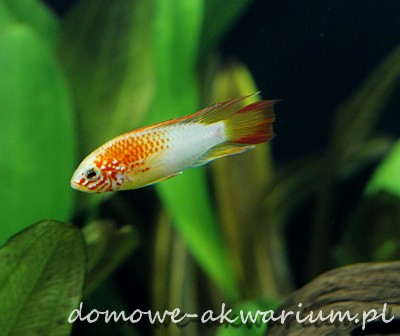
| Species | Red-Backed Dwarf Cichlid |
|---|---|
| Other names | Viejita Cichlid |
| Latin Name | Apistogramma Viejita |
| Family | cichlids |
| Origin | Ameryka Południowa |
| Length | 3,0 - 4,5 cm |
| Temperature | 23 - 30°C |
| Water Hardness | soft - medium hard |
| pH | 5,5 - 7,5 |
| Aquarium Size | 80 L |
| Food | gatunek mięsożerny |
Red-Backed Dwarf Cichlid, Viejita Cichlid, Umbrella Cichlid, Golden Dwarf Acara, Dwarf Butterfly Cichlid
A freshwater species that naturally inhabits the Orinoco River and its tributary - the Meta River in Colombia.
The species is characterized by a gray-olive-blue color of the body. Along the sides (from the mouth, through the eyes, to the base of the tail) extends an irregular dark stripe. A second one can be observed on the back. Fins and the area around the snout are yellowish (the tail fin is clearly yellow). External rays of the tail fin and the edge of the dorsal fin - red. There is also a gold variant of this species (in the photo) and a super red version. The species can be confused with Apistogramma macmasteri (the red-backed cichlid), which is slightly larger (male about 5.5 cm, up to 7 cm). The male of the described species is much larger than the female, more brightly colored, and has elongated rays of the dorsal, anal and caudal fins.

The species is usually calm. Only during the spawning period can it become more aggressive (especially males towards each other). If there is a predominance of females in the aquarium, a hierarchy will be established among males, with the dominant male at the head. Any male who does not submit to his domination will be chased away from the herd. Fish can be bred with peaceful species of similar sizes, e.g., armored catfish, plecos. We should avoid mixing with other species from the Apistogramma genus - there is a risk of crossbreeding species (hybridization).
The viejita cichlida requires a spacious aquarium - longer than higher, which will be abundantly planted with plants (e.g., frogbit), will have fine substrate (fine gravel or sand) and will contain numerous hiding places among tree roots, rocks or nut shells. Lighting and filtration moderate. Regular water changes are necessary - fish are sensitive to accumulated nitrogen compounds (nitrites, nitrates, and ammonia).
The species is oviparous, which is best bred in a separate tank with acidic and very soft water. The female lays eggs on the roof of the cave (even 100 grains) and she takes care of the offspring. The male guards his entire territory.